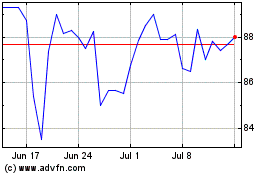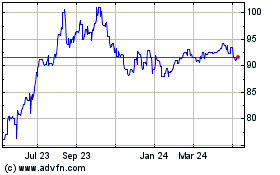UK Inflation Strongest Since Mid-2013
June 13 2017 - 4:10AM
RTTF2
UK inflation accelerated unexpectedly to the highest level in
four years as the weakness in the sterling since the 'Brexit' vote
made imports expensive.
Inflation rose to 2.9 percent in May from 2.7 percent in April,
data from the Office for National Statistics showed Tuesday.
This was the highest since June 2013 and notably above the
central bank's target of 2 percent. Economists had forecast the
annual rate to remain unchanged at 2.7 percent.
At the May monetary policy meeting, the Bank of England raised
its inflation outlook for this year to 2.7 percent from 2.4
percent. The projected overshoot entirely reflects the effects of
the falls in sterling since late November 2015 on import
prices.
However, Paul Hollingsworth, an economist at Capital Economics,
said today that inflation is now not far away from its peak.
While the squeeze on households' real incomes is likely to
intensify over the coming months and weigh on spending growth this
year, it should at least be less prolonged than after sterling's
last big devaluation in 2008/09, the economist added.
The Bank of England is widely expected to keep its key rate
unchanged at 0.25 percent until the outlook becomes clear after the
inconclusive general election. The election outcome has raised
uncertainties about Brexit negotiations.
Further, ONS data showed that core inflation that excludes
energy, food, alcoholic beverages and tobacco increased to 2.6
percent from 2.4 percent in April.
On a monthly basis, consumer prices gained 0.3 percent in May,
slightly faster than the 0.2 percent increase economists had
forecast.
The consumer prices index including owner occupiers' housing
costs advanced 2.7 percent annually in May versus 2.6 percent in
April.
Another report from the ONS showed that output price inflation
held steady at 3.6 percent in May. The rate came in line with
expectations.
The latest figures suggest the recent period of rapidly
increasing factory gate prices may have come to an end, the ONS
said.
Following the recent strength of sterling, input price inflation
eased to 11.6 percent, the weakest since September, from 15.6
percent, the ONS said. Economists had forecast inflation to slow
moderately to 13.5 percent.
Month-on-month, output prices edged up 0.1 percent compared to a
0.4 percent increase in April. Meanwhile, input prices fell 1.3
percent, following a 0.3 percent drop.
US Dollar vs RUB (FX:USDRUB)
Forex Chart
From Mar 2024 to Apr 2024

US Dollar vs RUB (FX:USDRUB)
Forex Chart
From Apr 2023 to Apr 2024
